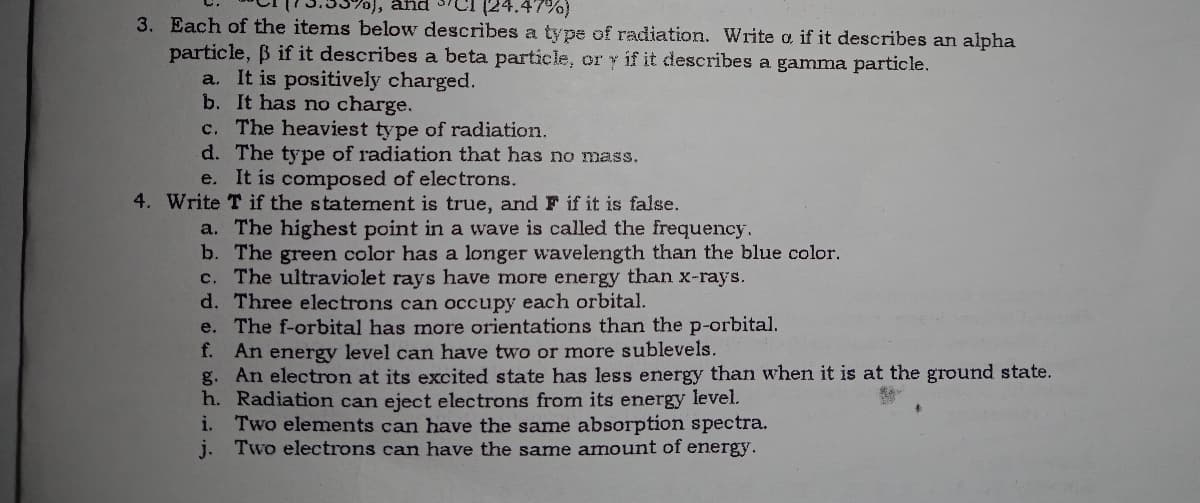3. Each of the items below describes a type of radiation. Write a if it describes an alpha particle, B if it describes a beta particle, or y if it describes a gamma particle. a. It is positively charged. b. It has no charge. c. The heaviest type of radiation. d. The type of radiation that has no mass. e. It is composed of electrons.
3. Each of the items below describes a type of radiation. Write a if it describes an alpha particle, B if it describes a beta particle, or y if it describes a gamma particle. a. It is positively charged. b. It has no charge. c. The heaviest type of radiation. d. The type of radiation that has no mass. e. It is composed of electrons.
Principles of Modern Chemistry
8th Edition
ISBN:9781305079113
Author:David W. Oxtoby, H. Pat Gillis, Laurie J. Butler
Publisher:David W. Oxtoby, H. Pat Gillis, Laurie J. Butler
Chapter19: Nuclear Chemistry
Section: Chapter Questions
Problem 46AP
Related questions
Question
100%

Transcribed Image Text:(24.47%)
3. Each of the items below describes a type of radiation. Write a if it describes an alpha
0), and
particle, B if it describes a beta particle, or y if it describes a gamma particle.
a. It is positively charged.
b. It has no charge.
c. The heaviest type of radiation.
d. The type of radiation that has no mass.
e. It is composed of electrons.
4. Write T if the statement is true, and F if it is false.
a. The highest point in a wave is called the frequency.
b. The green color has a longer wavelength than the blue color.
c. The ultraviolet rays have more energy than x-rays.
d. Three electrons can occupy each orbital.
e. The f-orbital has more orientations than the p-orbital.
f. An energy level can have two or more sublevels.
g. An electron at its excited state has less energy than when it is at the ground state.
h. Radiation can eject electrons from its energy level.
i. Two elements can have the same absorption spectra.
j. Two electrons can have the same amount of energy.
Expert Solution
This question has been solved!
Explore an expertly crafted, step-by-step solution for a thorough understanding of key concepts.
Step by step
Solved in 2 steps with 1 images

Knowledge Booster
Learn more about
Need a deep-dive on the concept behind this application? Look no further. Learn more about this topic, chemistry and related others by exploring similar questions and additional content below.Recommended textbooks for you

Principles of Modern Chemistry
Chemistry
ISBN:
9781305079113
Author:
David W. Oxtoby, H. Pat Gillis, Laurie J. Butler
Publisher:
Cengage Learning

Chemistry: An Atoms First Approach
Chemistry
ISBN:
9781305079243
Author:
Steven S. Zumdahl, Susan A. Zumdahl
Publisher:
Cengage Learning


Principles of Modern Chemistry
Chemistry
ISBN:
9781305079113
Author:
David W. Oxtoby, H. Pat Gillis, Laurie J. Butler
Publisher:
Cengage Learning

Chemistry: An Atoms First Approach
Chemistry
ISBN:
9781305079243
Author:
Steven S. Zumdahl, Susan A. Zumdahl
Publisher:
Cengage Learning


Chemistry
Chemistry
ISBN:
9781305957404
Author:
Steven S. Zumdahl, Susan A. Zumdahl, Donald J. DeCoste
Publisher:
Cengage Learning

Chemistry for Engineering Students
Chemistry
ISBN:
9781337398909
Author:
Lawrence S. Brown, Tom Holme
Publisher:
Cengage Learning

Chemistry: The Molecular Science
Chemistry
ISBN:
9781285199047
Author:
John W. Moore, Conrad L. Stanitski
Publisher:
Cengage Learning